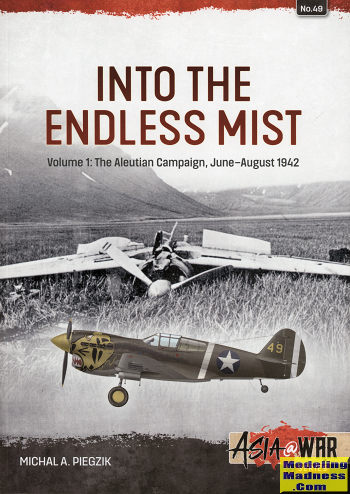 An almost
forgotten campaign of WWII was that of the Aleutians. The Japanese felt that
they needed a 'buffer' north of the country and so made plans to put an outpost
or two in the Aleutian Islands. This was not, as many have thought, used as a
feint for the Midway operation.
An almost
forgotten campaign of WWII was that of the Aleutians. The Japanese felt that
they needed a 'buffer' north of the country and so made plans to put an outpost
or two in the Aleutian Islands. This was not, as many have thought, used as a
feint for the Midway operation.
Planning was fairly straight-forward with US bases in
the eastern Aleutians to be attacked to prevent any interference with landings
on Attu and Kiska. Since it wasn't as major an operation as the one to Midway,
most of the naval vessels were what I'd call 'second class'. No large carriers,
no heavy cruisers, no battleships, instead what was provided turned out to be
quite adequate for the task.
The Japanese were not sure if there were any US units on
the two islands they planned on occupying, but it turned out that the only US
personnel were a weather station on Kiska. Kiska was going to be the main base
of the two as it had a good harbor for seaplanes and room for the invasion
ships.
The US was fairly quick to respond to the invasion,
however, the available forces were pretty meager and consisted of a small fleet
and some USN patrol aircraft and some army bombers and fighter. The aircraft
were fairly unsuccessful in their attempts at sinking ships, however, the
Japanese were successful in attacking US military installations on Kodiak
island. This freaked out the US as they feared that an invasion of mainland
Alaska was next so diverted a number of troops and equipment to Nome to perform
defensive duties that were eventually never needed to fight the Japanese. What
was fairly effective against the Japanes were US submarines which managed to
sink and damage a number of Japanese ships. All this was against the background
of some of the worst weather in the world where wind, fog, and cold fought both
sides.
This is volume one of the conflict and covers June to
August 1942 when things were generally going the Japanese way. The amount of
research done by the author is quite impressive as the book provides a lot of
detail from both sides of the conflict. A goodly number of period photos,
charts, tables and color profiles makes this a super read. I can, of course,
recommend this to you as you'll learn quite a bit about the opening months of
this campaign.
March 2024
Copyright ModelingMadness.com. All rights reserved. No
reproduction in part or in whole without express permission.
Review book courtesy of
Casemate Publishers, where you can order your copy
at this
link.
If you would like your product reviewed fairly and quickly, please
contact the editor or see other details in the
Note to
Contributors.
 An almost
forgotten campaign of WWII was that of the Aleutians. The Japanese felt that
they needed a 'buffer' north of the country and so made plans to put an outpost
or two in the Aleutian Islands. This was not, as many have thought, used as a
feint for the Midway operation.
An almost
forgotten campaign of WWII was that of the Aleutians. The Japanese felt that
they needed a 'buffer' north of the country and so made plans to put an outpost
or two in the Aleutian Islands. This was not, as many have thought, used as a
feint for the Midway operation.